STUART ROY - NAVAL ARCHITECT
Fellow of the Royal Institution of Naval Architects & Chartered Engineer
Part 4: Launching, rowing trial, naming by HM The Queen
With the hull nearing completion it was time to plan for the installation of the electrical and mechanical components which had been specified, set out on drawings and submitted to Lloyd’s Register by independent naval architect Graham Westbrook, with whom I worked at Camper & Nicholsons almost 40 years ago. The project manager then recruited Dave Robins from Nielsen & Co of Gloucester to be the vessel’s engineer and work with Graham to install, test and commission the various mechanical and electrical systems. Four British companies worked together to supply a propulsion system of batteries, motors, legs & propellers.
When the framework for the “coach” was in place Kate Woods joined the team in the New Year to advise on the interior design, fabrics and furnishings. Kate had been responsible for the decoration of Thames passenger boats from the Silver Fleet and brought many valuable ideas. In the spring the established company Hare & Humphreys was commissioned to add the artwork and finishing touches to the boat. These included the full external gilding process that took 1500 books of 23.5-carat gold leaf, internal painted panels based on the birds of the Thames, cockpit panels of an anchor design representing the Lord High Admiral and the long external wave pattern that runs along the sheer line (also known as ‘running dog’) as well as decorating the rudder and oars with sea serpents as seen on Prince Frederick’s barge.
All passenger vessels are required to have an approved Safety Management System described in detailed documentation typically including an operations manual, training manual, search and rescue plan and vessel handbook. Sponsored by Thames Clippers the documentation was expertly prepared by marine safety specialists Roger Flitter and Derek Mann, relieving the design team of a difficult and time-consuming task.
In the end the main structure of Gloriana was all completed and ready to launch in a total build time of 22 weeks. Throughout the build process the surveyors from Lloyds Register and the MCA made weekly inspections of the part-built vessel usually followed by long meetings with the design and technical team.
The day of Gloriana’s launching started with a glimpse on breakfast TV of a magnificent gilded boat being driven before dawn through narrow suburban streets to the riverside at Isleworth to await the tide. The weather couldn’t have been worse with persistent heavy rain, lightning and hail, but in a brief clearance Lord Sterling made a short speech, the church bells rang out, the crowd cheered and Gloriana was lowered into the water, the decks white with accumulated hail. After every compartment had been checked for leakage before the crane slings were removed, we went aboard and a scratch crew of 18 prepared to use the 16ft sitka spruce oars decorated with sea-serpents to row her for the first time, commanded by the Queen’s Bargemaster and designated pageant skipper Scott Neicho. Within a few strokes she was moving steadily at around 4.5 knots and the designers knew at last that she was not too big or too heavy and would indeed fulfil her role, just as planned. On the short delivery trip under oars to Mark’s boatyard at Richmond Bridge for the remaining fitting-out work, it was interesting that one could feel this large boat accelerate each time the oars were pulled, indicating what a good hull shape had evolved over the years for large man-propelled vessels.
A week later much more ornamental gilded sculpture had been fitted, including regal crests above the companionways, 16 small shields showing a coat of arms of a Commonwealth country at the head of each cabin pillar, six flagpoles with dolphins at their bases (four more were added later) and two gorgeous golden lions which sit either side of the boarding deck gate. The artists had completed the painted ceiling panels of the birds of the Thames in the cabin and symbolic anchor murals on the back of the “coach”. A carpet with the Queen’s cipher set in a fretwork design had been woven by hand in Nepal and laid in the cabin. It was then time to invite HM the Queen to come and name Gloriana before Her Majesty attended the official opening of the newly-restored Cutty Sark at Greenwich.
On a cold wet day with a vicious easterly wind blowing, Gloriana was towed down river to Greenland Pier to be named. The Queen’s Watermen came on board in their red dress-uniforms and the Royal Standard was hoisted. Her Majesty walked briskly down the jetty to the pier level where the design and build team were waiting. She was introduced by Lord Sterling to the leading shipwright Tyrone Marlow, myself and Ed. Then the Queen and Duke went aboard Gloriana and inspected the cabin and aft cockpit before coming back onto the pontoon to name the boat. The weather was so miserable that the Queen only stayed a few minutes but everyone’s mood was lifted enormously so that the visit was still being discussed an hour later as we all warmed up in the nearby floating pub. The Queen has sparkly eyes, smiles readily and when there is something to be done she doesn’t let horizontal rain and a gale put her off. After the Queen and Duke had left, Gloriana was rowed by the Queen’s Watermen down to Greenwich – this was the first time a Royal Barge had been rowed off Greenwich since 1849.
Part 5 - Trials & The Pageant
With the hull nearing completion it was time to plan for the installation of the electrical and mechanical components which had been specified, set out on drawings and submitted to Lloyd’s Register by independent naval architect Graham Westbrook, with whom I worked at Camper & Nicholsons almost 40 years ago. The project manager then recruited Dave Robins from Nielsen & Co of Gloucester to be the vessel’s engineer and work with Graham to install, test and commission the various mechanical and electrical systems. Four British companies worked together to supply a propulsion system of batteries, motors, legs & propellers.
When the framework for the “coach” was in place Kate Woods joined the team in the New Year to advise on the interior design, fabrics and furnishings. Kate had been responsible for the decoration of Thames passenger boats from the Silver Fleet and brought many valuable ideas. In the spring the established company Hare & Humphreys was commissioned to add the artwork and finishing touches to the boat. These included the full external gilding process that took 1500 books of 23.5-
All passenger vessels are required to have an approved Safety Management System described in detailed documentation typically including an operations manual, training manual, search and rescue plan and vessel handbook. Sponsored by Thames Clippers the documentation was expertly prepared by marine safety specialists Roger Flitter and Derek Mann, relieving the design team of a difficult and time-
In the end the main structure of Gloriana was all completed and ready to launch in a total build time of 22 weeks. Throughout the build process the surveyors from Lloyds Register and the MCA made weekly inspections of the part-
The day of Gloriana’s launching started with a glimpse on breakfast TV of a magnificent gilded boat being driven before dawn through narrow suburban streets to the riverside at Isleworth to await the tide. The weather couldn’t have been worse with persistent heavy rain, lightning and hail, but in a brief clearance Lord Sterling made a short speech, the church bells rang out, the crowd cheered and Gloriana was lowered into the water, the decks white with accumulated hail. After every compartment had been checked for leakage before the crane slings were removed, we went aboard and a scratch crew of 18 prepared to use the 16ft sitka spruce oars decorated with sea-
A week later much more ornamental gilded sculpture had been fitted, including regal crests above the companionways, 16 small shields showing a coat of arms of a Commonwealth country at the head of each cabin pillar, six flagpoles with dolphins at their bases (four more were added later) and two gorgeous golden lions which sit either side of the boarding deck gate. The artists had completed the painted ceiling panels of the birds of the Thames in the cabin and symbolic anchor murals on the back of the “coach”. A carpet with the Queen’s cipher set in a fretwork design had been woven by hand in Nepal and laid in the cabin. It was then time to invite HM the Queen to come and name Gloriana before Her Majesty attended the official opening of the newly-
On a cold wet day with a vicious easterly wind blowing, Gloriana was towed down river to Greenland Pier to be named. The Queen’s Watermen came on board in their red dress-
Part 5 -
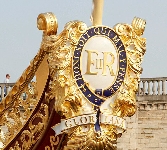
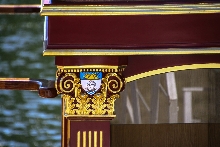
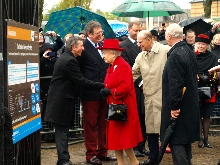
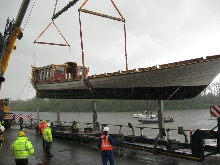
Launching at Isleworth 19th April 2012
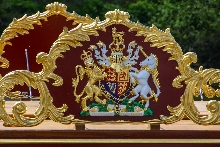
The magnificent aft crest and name board
Arms of every Commonwealth country
The Royal Coat of Arms on side shields
HM the Queen arriving to name Gloriana
Gloriana rowed by the Queen’s Watermen
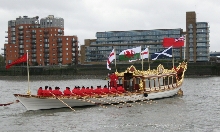
Creating “Gloriana” - The Naval Architect’s story ………….
Index - click to activate link
Part 1 - Historial References
Part 2 - The design proposal
Part 3 - Construction
Part 4 - Launching
Part 5 - Trials & The Pageant
Larger Photographs
Part 2 -
Part 3 -
Part 4 -
Part 5 -
Larger Photographs